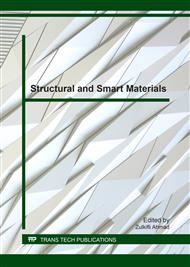[1]
Zohrevand, P. and A. Mirmiran, Behavior of ultra high-performance concrete confined by fiber-reinforced polymers, Mater. Civ. Eng. 23(12) (2012) 1727-1734.
DOI: 10.1061/(asce)mt.1943-5533.0000324
Google Scholar
[2]
Vincent, T. and T. Ozbakkaloglu, Influence of concrete strength and confinement method on axial compressive behavior of FRP-confined high- and ultra high-strength concrete, Compos. Part B 50 (2013) 413-428.
DOI: 10.1016/j.compositesb.2013.02.017
Google Scholar
[3]
Lim, J.C. and T. Ozbakkaloglu, Hoop strains in FRP-confined concrete columns: experimental observations, Mater. Struct. (2014) DOI: 10. 1617/s11527-014-0358-8.
DOI: 10.1617/s11527-014-0358-8
Google Scholar
[4]
Ozbakkaloglu, T. and T. Vincent, Axial compressive behavior of circular high-strength concrete-filled FRP tubes, ASCE, J. Compos. Constr. 18(2) (2014) 04013037.
DOI: 10.1061/(asce)cc.1943-5614.0000410
Google Scholar
[5]
Vincent, T. and T. Ozbakkaloglu, Influence of slenderness on stress-strain behavior of concrete-filled FRP tubes: an experimental study, ASCE, J. Compos. Constr. 10. 1061/(ASCE)CC. 1943-5614. 0000489, 04014029 (2014).
DOI: 10.1061/(asce)cc.1943-5614.0000489
Google Scholar
[6]
Lim, J.C. and T. Ozbakkaloglu, Influence of Concrete Age on Stress-Strain Behavior of FRP-Confined Normal- and High-Strength Concrete, Constr. Build. Mater. 82 (2015) 61-70.
DOI: 10.1016/j.conbuildmat.2015.02.020
Google Scholar
[7]
Lim, J.C. and T. Ozbakkaloglu, Influence of silica fume on stress-strain behavior of FRP-confined HSC, Constr. Build. Mater. 63 (2014) 11-24.
DOI: 10.1016/j.conbuildmat.2014.03.044
Google Scholar
[8]
Wong, Y.L., et al., Behavior of FRP-confined concrete in annular section columns, Compos. Part B 39(3) (2008) 451-466.
DOI: 10.1016/j.compositesb.2007.04.001
Google Scholar
[9]
Louk Fanggi, B. and T. Ozbakkaloglu, Compressive behavior of aramid FRP-HSC-steel double-skin tubular columns, Constr. Build. Mater. 48 (2013) 554-565.
DOI: 10.1016/j.conbuildmat.2013.07.029
Google Scholar
[10]
Ozbakkaloglu, T. and B. Louk Fanggi, FRP-HSC-steel composite columns: behavior under monotonic and cyclic axial compression, Materials and Structures (2013) doi: 10. 1617/s11527-013-0216-0.
DOI: 10.1617/s11527-013-0216-0
Google Scholar
[11]
Albitar, M., T. Ozbakkaloglu, and B. Louk Fanggi, Behavior of FRP-HSC-Steel double-skin tubular columns under cyclic axial compression, ASCE, J. Compos. Constr. DOI: 10. 1061/(ASCE)CC. 1943-5614. 0000510, 04014041. (2014).
DOI: 10.1061/(asce)cc.1943-5614.0000510
Google Scholar
[12]
Idris, Y. and T. Ozbakkaloglu, Flexural behavior of FRP-HSC-steel composite beams, Thin-Walled Structures 80 (2014) 207-216.
DOI: 10.1016/j.tws.2014.03.011
Google Scholar
[13]
Ozbakkaloglu, T. and Y. Idris, Seismic behavior of FRP-high-strength concrete-steel double skin tubular columns, ASCE, J. Struct. Eng 140(6) (2014) 04014019.
DOI: 10.1061/(asce)st.1943-541x.0000981
Google Scholar
[14]
Idris, Y. and T. Ozbakkaloglu, Flexural Behavior of FRP-HSC-Steel Double Skin Tubular Beams under Reversed-Cyclic Loading, Thin-Walled Structures 87 (2015) 89-101.
DOI: 10.1016/j.tws.2014.11.003
Google Scholar
[15]
Louk Fanggi, B. and T. Ozbakkaloglu, Square FRP-HSC-steel composite columns: Behavior under axial compression, Eng. Struct. 92 (2015) 156 - 171.
DOI: 10.1016/j.engstruct.2015.03.005
Google Scholar
[16]
Louk Fanggi, B. and T. Ozbakkaloglu, Behavior of Hollow and Concrete-Filled FRP-HSC and FRP-HSC-Steel Composite Columns Subjected to Concentric Compression, Adv. Struct. Eng. 18(5) (2015) 715-738.
DOI: 10.1260/1369-4332.18.5.715
Google Scholar
[17]
Vincent, T. and T. Ozbakkaloglu, Compressive behavior of prestressed high-strength concrete-filled aramid FRP tube columns: Experimental observations, ASCE, J. Compos. Constr. 10. 1061/(ASCE)CC. 1943-5614. 0000556 (2015) 04015003.
DOI: 10.1061/(asce)cc.1943-5614.0000556
Google Scholar
[18]
Ozbakkaloglu, T., J.C. Lim, and T. Vincent, FRP-confined concrete in circular sections: Review and assessment of the stress-strain models, Eng. Struct. 49 (2013) 1068-1088.
DOI: 10.1016/j.engstruct.2012.06.010
Google Scholar
[19]
Teng, J.G., et al., Theoretical model for fiber reinforced polymer-confined concrete., ASCE J. Compos. Constr. 11(2) (2007) 201 - 210.
DOI: 10.1061/(asce)1090-0268(2007)11:2(201)
Google Scholar
[20]
Lim, J.C. and T. Ozbakkaloglu, Unified Stress-strain model for FRP and actively confined normal-strength and high-strength concrete, ASCE, J. Compos. Constr. 10. 1061/(ASCE)CC. 1943-5614. 0000536 (2014) 04014072.
DOI: 10.1061/(asce)cc.1943-5614.0000536
Google Scholar
[21]
Lim, J.C. and T. Ozbakkaloglu, Lateral strain-to-axial strain relationship of confined concrete, ASCE, J. Struct. Eng (2014) doi: 10. 1061/(ASCE)ST. 1943-541X. 0001094.
DOI: 10.1061/(asce)st.1943-541x.0001094
Google Scholar


